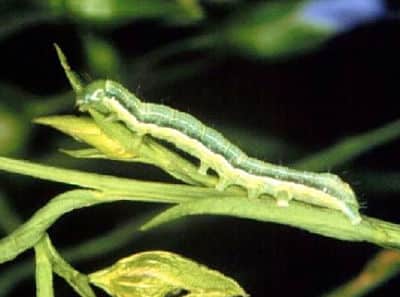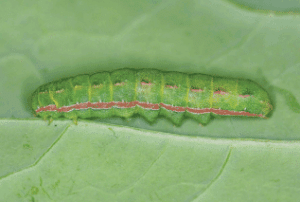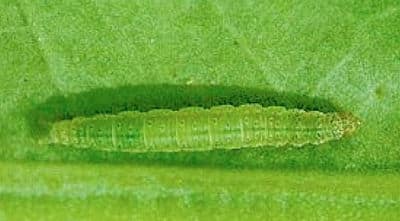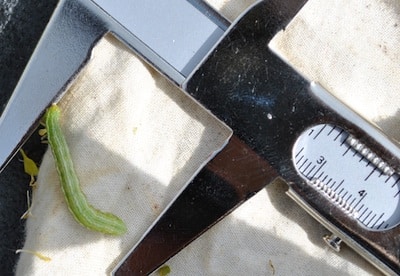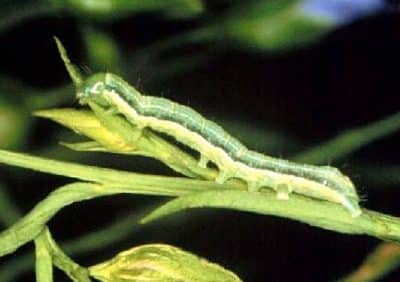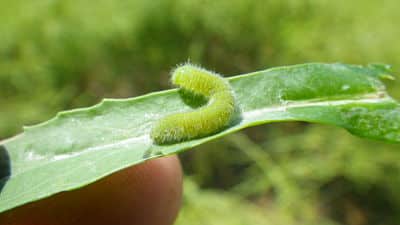Before spraying, make sure your canola is at the right stage to be damaged by the worms and that the worms are actually the species you’re trying to control. Here’s how to tell the difference:
Bertha armyworm. Berthas come in brown, black and green shades. The green berthas are shinier than other green worms, and the yellow-orange stripe along each side is more pronounced, even on younger ones. Mature larvae are up to 1.5” long, making them considerably larger than diamondback moth larvae at late stages. Being part of the cutworm family, they also curl up when agitated. While cabbageworms tend to stay on the leaves as long as leaves are available, bertha will move up into the pods earlier. Read more.
Clover cutworm. Clover cutworm is easy to confuse with bertha armyworm. They are about the same size when mature (1” to 1.5”). They can both be green or brown, even black. They both have stripes down the side. The key differences are that the clover cutworm strip is pink and the bertha stripe is yellow or orange, and that clover cutworms cycle earlier. They are large at this stage of the season, often mature and starting to pupate, while bertha armyworm, if present at all as larvae, will be tiny. People are noticing clover cutworm this week, thinking they’re berthas, and wonder if they should be on high alert for berthas already. Manitoba Agriculture’s provincial entomologist John Gavloski says that in rare cases, clover cutworms can cause economic levels of damage in areas within a canola field. But in most instances, levels are lower and spraying is not usually worth considering. Read more.
Diamondback moth larvae. When agitated, diamondback moth larvae will wiggle backwards and dangle from the plant on a thread. Diamondback moth larvae are spindle shaped — fatter in the middle than at the end. They also rarely grow beyond 12 mm (0.5”) in length, versus bertha larvae which can reach 4 cm (1.5”). The threshold for diamondback larvae is about 200 per square metre. Read more.
Imported cabbageworm (larvae of cabbage butterfly). These worms are light green with a lemon-yellow stripe down the middle of the back (dorsal side). They are covered with short hairs giving it a velvety appearance. They grow to about 30 mm. Cabbageworms look more like diamondback moth larvae than bertha armyworms, but are more docile than diamondback moth larvae and less spindle shaped. As long as there is good vegetative growth, they feed mostly on leaves and it is not usually economical to spray them. Some growers have reported 8-10 per plant, but before spraying, check regularly to see if damage ceases over the next week. Cabbageworms have 2-3 generations per year and will go into pupal stage quicker than the other two larvae. Most cabbageworms in southern Alberta are infested with parasitoids, so they feed less and die before pupating. Read more.
Alfalfa looper. Loopers are 24 mm long (1”) with light green or olive color, and a paler head than berthas. They have a light stripe down each side and two light stripes along the back. Mature larvae have a swollen abdomen. There is no economic threshold available. Delaying insecticide application as long as possible may allow viral diseases to reduce populations. Read more.
Scout throughout each field. Insects may be concentrated only in certain areas in the field, while the rest of the field is not seriously affected. A blanket spray of the whole field may not be warranted. Larval numbers can also vary substantially between fields in close proximity, depending on crop staging and the attractiveness of the field at egg laying.
